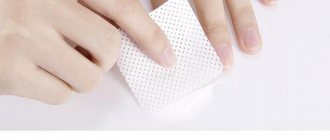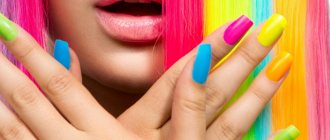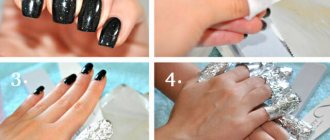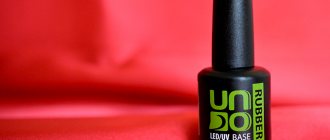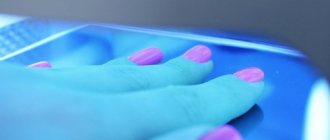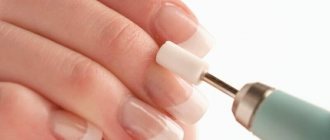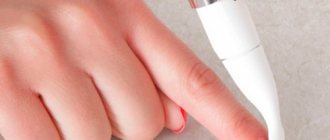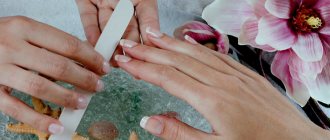Many girls enjoy wearing gel polish so much that it is not surprising that they begin to master the shellac technique at home. And they are not stopped by the fact that high-quality varnishes and decorative elements for creating a manicure are sometimes expensive. If you wish, it is not at all difficult to master shellac at home. What do you need for this? This is the main question, because sometimes we simply forget about many necessary things.
You should never forget about the clinser - you will need it both at the stage of nail preparation and to complete the procedure. It makes it easy to degrease the nail at the beginning of the procedure. But many people simply use primer as a cleaner and dehydrator. But at the end of the procedure it will be of no use. It is not used to remove stickiness.
How can you remove the sticky layer of gel polish? Beginners who have bought a topcoat and realized that it leaves a strange stickiness are interested in it. And in general, should this layer be removed, what liquids can remove it, and is it possible to replace them with something at hand? Let's try to understand this issue.
How to replace a clinser
It happens that the clinser runs out at the most inopportune moment and in such situations the question of replacement arises. Let's start with what should not be replaced with a clinser:
- nail polish remover with acetone .
The strongest solvent in the composition is designed to destroy the bonds of coatings, so even in minimal quantities it can affect the durability of the manicure. In addition, after using a solvent, the surface may lose its shine and become cloudy; Coating remover - how to choose and use - degreaser. A degreaser, if it is not a universal 2 in 1 product, is used to remove sebum, while the cleanser destroys the breakdown products of the material. You can use a degreaser to remove stickiness, but only as a last resort. After using a degreaser for purposes other than its intended purpose, cracks in the coating may appear faster;
If you don’t have a clinser at hand, you can remove the stickiness:
- alcohol wipes. Alcohol-impregnated wipes are purchased for medical purposes - local injections or wound treatment. Alcohol wipes remove stickiness well, practically without harming the color and quality of the coating;
- medical alcohol or alcohol tincture . Before using such a “cleaner”, it is recommended to dilute the alcohol with water in a ratio of 1:3 – 1 tablespoon of alcohol to 3 tablespoons of water to reduce the concentration. Concentrated alcohol dries out the skin and causes the coating to become cloudy.
Of course, to work with the inhibited layer, it is better to use specialized products that do not harm the manicure and the skin around the nails, or purchase a non-sticky top, for example, from Kodi with the “No sticky” mark.
Types of topcoats: how to choose a topcoat, review of the 10 best brands
Is it possible to remove the sticky layer with a degreaser?
How can you remove the sticky layer if the cleaner runs out at the wrong time, and there is no time or nowhere to buy a new one? Most often, a degreaser is used as a replacement, which is usually on hand and is intended for almost the same purpose.
But it is important to understand that a degreaser removes skin secretion products, and the substances that create a dispersion film on the surface of the nail plate have a completely different composition. Therefore, it is worth using not a special product, but available substitutes only when there are no other options. But in this case, you shouldn’t be surprised if the manicure fades, and small cracks begin to appear on the coating within a week.
How to choose a cleaner
- compound . Make sure that the composition contains oils - lavender, rosemary. And extracts, for example, chamomile. Additional components take care of the nail and allow the cleanser not to dry out the skin;
- clinsers with pump dispenser . They are much more convenient to use and allow you not to be distracted by wetting the napkin;
- smell. A pungent odor, both chemical and fragrance, can cause headaches if inhaled for a long time. Try to purchase cleansers with an unobtrusive smell.
What is a primer and when is it needed?
What is the sticky layer and why does it remain?
When performing a manicure at home, enterprising young ladies take into account many points: the quality of the coating itself and accompanying decorative materials, sharpening the working edges of scissors or tweezers, as well as the optimal abrasiveness of the nail file. All this is under the sensitive attention of the craftswoman. The one thing that is often overlooked is removing the sticky layer. No, no, we are not talking about the standard removal of stickiness from the finishing top, but about the dispersion layer of the classic gel.
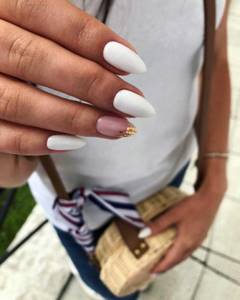
In order to answer the question asked 100% correctly, it is important to understand what exactly the mixture contained in the shellac bottle consists of. In fact, contrary to popular belief, the entire periodic table is not hidden behind transparent glass walls. Most often, the following ingredients can be seen in the formula:
| Formula Component | Its purpose |
| Plasticizers | Particles of a substance that gives the polymerized gel elasticity and plasticity. Plasticizers are especially important at the moment when there is a mechanical effect on the nail plate. It is the quality of the plasticizer raw material that determines whether the coating will be chipped or not. |
| Polymers | Another mandatory item in the list of ingredients of any gel polish. Polymers are designed to improve durability and increase the degree of adhesive adhesion of natural nail keratin to artificial coating. It is logical that in expensive varnishes the plasticizers are also of higher quality, while in budget ones they are cheaper |
| Solvents | It is a mistake to believe that polymerization is an ordinary process of hardening varnish under a UF or LED lamp. In fact, polymerization is the process of evaporation of solvents from the surface of the coating, due to which it hardens |
| Silicates | An auxiliary ingredient that should also be included in any varnish. Silicates control the degree of pigment settling and prevent the varnish from delaminating; they are also responsible for the overall viscosity of the consistency |
| Titanium dioxide | Another “chemical” ingredient. Essentially, this is a snow-white pigment that is added to almost every gel polish to emphasize the intensity of the original shade. |
| TSF | Perhaps the most “controversial” component of varnish. It is designed to improve the degree of adhesion of the coating and the nail plate, which directly affects the durability of the manicure. But such an additive is safe only in the absence of formaldehyde. Read the ingredients carefully |
| Mica | The component thanks to which we observe a delicate pearl shimmer. Essentially, mica is an accumulation of finely dispersed reflective particles that block direct sunlight or artificial rays |
| Camphor | The same plasticizer, but of natural origin. At the moment, camphor is being removed from use, as it is a powerful allergen. |
This, perhaps, is the entire “base” on the basis of which shellac or gel polish is then formed. Naturally, each of the presented components directly affects the quality of the coating itself, its intensity and durability, but part of the responsibility for this also lies with the master who processes the nail plates. So what is this sticky layer of shellac? Essentially, polymerization is the process of turning a measure into a viscous but liquid consistency, which gradually hardens under UF or LED lighting by evaporating solvents. As a result of this metamorphosis, a sticky layer called a dispersion layer is formed on the hard surface. It is needed for adhesion of materials of different nature. In the case of gel manicure, to increase the adhesive ability of the artificial gel and natural keratin contained in the nails.
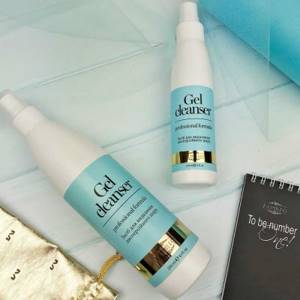
In other words, dispersion is a by-product of drying the gel coating, necessary for better bonding of all layers of the gel and the natural nail. And answering the question: “Do I need to remove the sticky layer from the base?” – the answer is clear – “No!” A sticky layer is simply necessary so that all layers of the manicure - base, color and top - adhere well to each other. When removing the dispersion, both from the base and from the color layers, the manicure loses its strength; it chips and peels off from the nail faster.
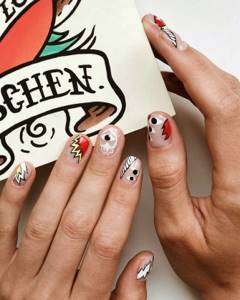
The best cleansers for removing stickiness
Sophin
The liquid has an unobtrusive odor and effectively removes the sticky layer. The active ingredient is isopropyl alcohol.
Grattol, Liquid 3 in 1
A multifunctional product suitable for making it easier to work with polygel, degreasing the nail plate and removing stickiness after polymerization. Prevents chipping and also gives the top coat extra shine.
Kinetics, Di-Tac
The peach scented cleanser is suitable for treating nails after polymerization, as well as for cleaning brushes after gel, polygel and acrylic. To remove stickiness, a cotton pad is moistened with liquid and used for its intended purpose. To clean your brushes, wrap the fleecy part in a soaked cotton pad or sponge for a couple of minutes.
Kodi Cleanser
The liquid allows you to remove the result of the decomposition of the material after polymerization without compromising the gloss of the coating. To prevent the color from becoming cloudy, the manufacturer recommends using a clean part of the napkin for each nail and covering the nails with Kodi top coat.
Severina, Adhesive Remover
Liquid for removing the sticky layer while maintaining the shine of the coating. The composition includes panthenol, which moisturizes and softens the skin around the nails. Can be used as a nail polish remover for natural and artificial nails.
How to remove the sticky layer from nails?
How to remove the sticky layer of shellac? Cleanser is a universal option that is optimal for processing both top and base. It contains approximately 2/3 water mixed with 1/3 alcohol (this figure varies depending on the manufacturer, so it is recommended to study the composition), as well as oils and fragrances.
You can purchase odorless liquids or products with a pleasant aroma. If we are talking about a cleanser for home use, then the choice depends on personal preferences, but for professional use it is better to choose anti-allergenic products.
Klinser can be used for various purposes, among the main ways of using it are the following:
- Degreasing the nail before starting to work on the manicure - for this purpose it is worth buying a 2-in-1, both a cleanser and a dehydrator.
- Cleaning and disinfection of manicure tools and brushes - with its help it is easy to remove remnants of gel polish and disinfect the surface (due to the presence of alcohol in the composition).
- Removing the sticky layer from gel polish is the main purpose. After its use, the coating will not lose its shine, its durability will be excellent.
Cleanser is used very economically, which makes such a purchase quite profitable. If you apply it with special lint-free wipes, then one bottle will last for six months or even a year of home use. And for professional use, such a product is absolutely required - this is important not only for creating a high-quality manicure, but also for the reputation of the master. It is better to select all the products from one company (base, top, cleanser), but this is not a mandatory requirement.
Subtleties of the process at home
Before using the solution to remove the sticky layer, you need to complete all the stages of a classic manicure:
- Rough treatment of the nail bed.
- Applying dehydrator.
- Fixation of the decorative coating - base, main color pigment, top.
- Removing the sticky layer.
A sticky base is formed after the gel polish is polymerized in an ultraviolet or LED lamp, but sometimes it can be confused with incomplete drying of shellac, so it is important to first hold your hands in the lamp for 1.5-2 minutes.
You need to be especially careful when working with a matte finish. The delicate, vulnerable coating can be accidentally damaged, ruining the manicure. Because of this, you can only use a manicure cleaner or nail polish remover without acetone, so as not to spoil the matte effect.
Glossy manicure is easier to work with, but it is important to follow some recommendations:
- The solution should not be used immediately after drying the shellac. Let it cool a little and harden in the air, otherwise you will ruin the glossy effect, the work will almost immediately become cloudy. Typically, for this you need to wait 1-2 minutes;
- You need to use special manicure napkins made of cellulose for the procedure, since only they provide a positive result. You cannot use cotton wool or cotton pads for this, as they will leave lint on the surface;
- When using the product, you need to run it along the nail plate 1-2 times. You should not rub your nail too hard, as this increases the risk of damage to the decorative coating;
- When using improvised aggressive compounds instead of a cleanser, you should first treat the periungual area with oil or fatty cream. This will prevent damage to your sensitive skin by protecting it from chemicals.
By carefully removing the finishing layer, you will preserve the quality of the applied gel polish and also eliminate the sticky layer.
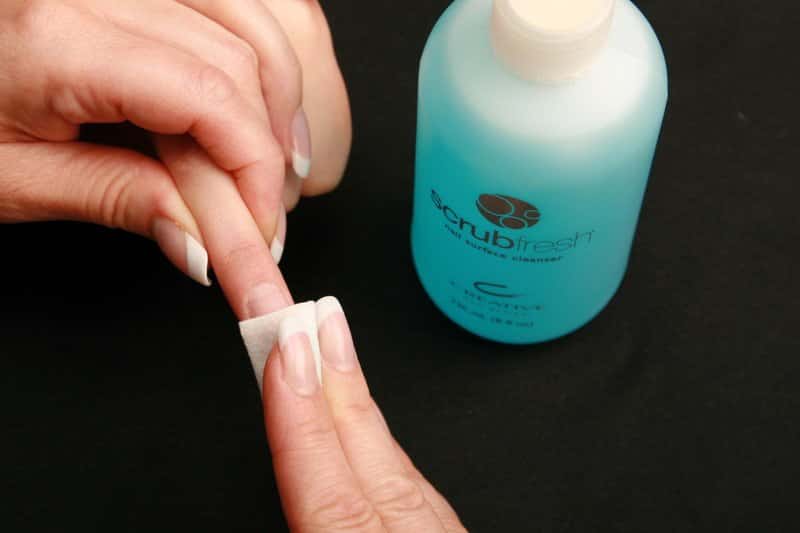
Keep in mind that, if possible, you should use a special solution; moreover, its direction of action is universal:
- Degreasing the nail bed. Before applying a decorative coating, you should always use a solution to remove the fatty film and normalize the acid balance, which will prevent the manicure from coming off prematurely. Due to the active ingredients contained in the clinser, part of it is used instead of a dehydrator. And if used before shellac, it also replaces the application of a primer to increase adhesion.
- Disinfection of instruments. Since the solution contains an alcohol base, it is often used to sterilize instruments and devices, especially at home. By neutralizing pathogenic microflora, you will reduce the risk of infection entering the body.
- Eliminate stickiness. The main purpose for which the liquid is used. Klinser is a relatively inexpensive product when compared with other compositions used when applying decorative coatings, so it is recommended to use it rather than improvised solutions. In addition, they often affect the quality of the work applied.
Homemade substitute
Many people keep a bottle of good vodka in their house for a special occasion. If there is one in the bins, then you need to get it, because high-quality vodka is considered one of the best substitutes for expensive clinser.
The dispersion layer removed with vodka does not damage the color and gloss. It must be remembered that vodka should only be of good quality. She will be able to remove the sticky layer of gel polish, while the color and structure will remain intact.
When purchasing materials, it is very important to take into account the fact that a cheap gel set from a little-known manufacturer does not last long, and the color of the coating instantly changes if you use low-quality cleaner substitutes, which cannot be said about expensive analogues. However, not everyone can afford professional products, so the choice is always up to the fashionista.
What to do if the sticky layer comes off with the varnish?
Often, after polymerization and removal of the dispersion layer, the gel varnish itself goes along with the napkin. What is the problem and how to avoid this unpleasant phenomenon? Think about it, you may be making the following mistakes:
- Do not dry the varnish completely. Check the timer on the lamp and adjust the drying time depending on the manufacturer's requirements;
- replace the lamps. There is a possibility that it is your lamp that is faulty, then you just need to change the light source to a more advanced and new one;
- Perhaps this defect is caused by poor-quality liquid. Check its composition for the presence of acetone. If its percentage is exceeded, either do not use this bottle, or try diluting it with water;
- if there is more pigment in a color gel than necessary, then with a considerable degree of probability it will not polymerize well;
- Pressing the plate too hard while removing the dispersed layer can also cause imperfections. Your movements should be progressive and soft.

Almost certainly, when “holes” form in the coating, one of the above reasons is to blame. Analyze the information and correct your mistake.
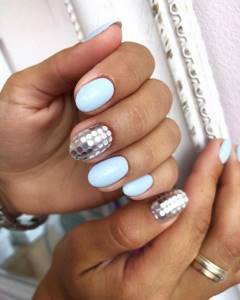
Analogue version of the clinser – dehydrator
Having dealt with the question of what a clinser is, let's take a closer look at its most common analogue - a nail dehydrator. Undoubtedly, many have heard about it, and perhaps this is what you use to degrease the nail plate and remove the dispersion layer. Perhaps someone will even decide that these are again different names for the same product. And someone, reading the previous section, will decide that they are missing an important point in manicure by using a dehydrator and forgetting about the cleanser.
Photo from the site: nogti.viberi.net
Both are wrong. Yes, a dehydrator and a cleanser have similar functions, properties and purposes, but they are completely different means. Thus, the cleanser acts more gently and removes only the natural fat layer from the nail plate. A dehydrator, in addition to removing the fat layer, removes excess water from the nail plate, penetrating deep into the nail. Thus, the dehydrator provides more reliable adhesion to the nail plate.
Interesting
Despite the fact that the dehydrator dries out the nail plate, it is the most gentle product among the group of degreasers. Its main active ingredient, butyl acetate, evaporates very quickly. After using the dehydrator, the pH balance is restored in the shortest possible time. In addition, once it gets on the skin, it does not cause irritation or allergic reactions.
Naturally, everyone must decide for themselves which product they will use to prepare their nails for applying gel polish. You just need to indicate in what cases it would be more appropriate to use one or another degreasing solution.
- If you have “wet” nails, then a dehydrator is your option. How to determine the “wetness” of nails? Only by experience. You may have noticed that you or your friends' manicures, done according to all the rules, begin to come off after just a couple of days, while for others it lasts for weeks. And so time after time. All this means that your nails are too wet. It is in your case that a dehydrator is the best option.
- If, on the contrary, you have excessively dry nails, then a dehydrator is contraindicated for you, because it will dry them out even more. You can also “identify” a dry nail plate experimentally. As a rule, after applying a dehydrator, the free edge of “dry” nail plates curls into a kind of cone. It is in this case that only a clinser should be used.
What to use at the final stage is no longer so important, and the cleanser and dehydrator do an excellent job of removing the sticky layer and providing a glossy shine to the manicure.
Review of popular degreasers
For a good manicure, you don’t have to buy a lot of bottles. Often, nail technicians, to save money, use universal or multifunctional liquids that combine several products. Available in packaging with different amounts of liquid in bottles.
Severina. The Severina degreaser has a relatively low cost, while combining the standard functions of a degreaser and a classic cleaner. Eliminates excess moisture from the surface layers of the nail.
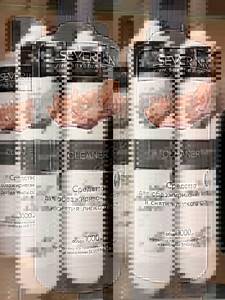
Orly. The 3 in 1 Gel FX Cleanser combines three necessary products that need to be used to treat the nail before and during a manicure: a degreaser, a dehydrating dehydrator, and a dispersion-removing clinser.

Canni . A harmonious tandem of degreaser and dehydrator in one bottle. Professionally prepares the nail plate for any nail modeling system.

My Nail. Prep Nail combines two professional products – a dehydrator and a degreaser. Recommended for use before gel extensions or gel polish coating.
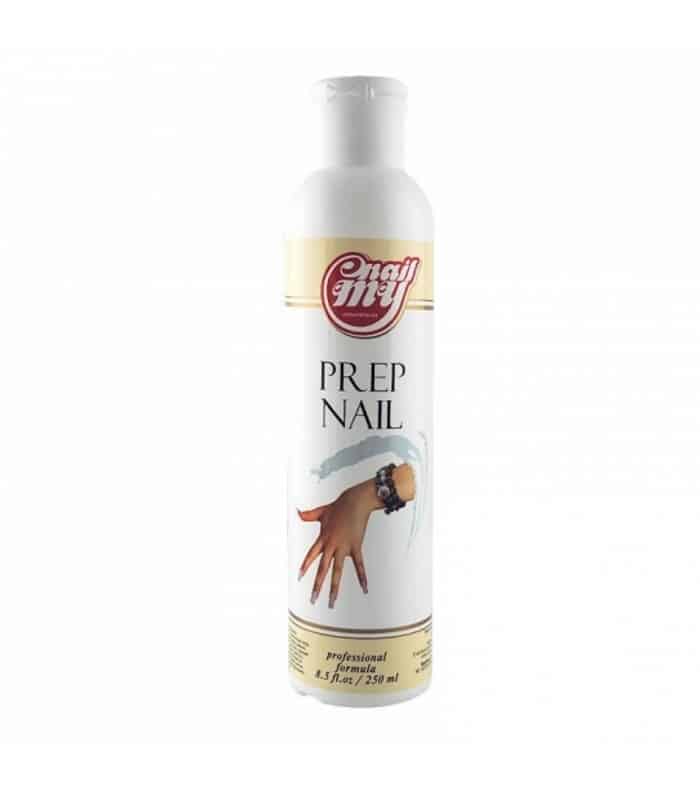
Kodi . Cody's Nail fresher product thoroughly degreases, removes excess moisture, disinfects, and acts as an acid-free primer. Suitable for use before coating with any material.

You probably don't know:
- How to use acrylic powder to strengthen nails?
- Acrylic on your own nails
- Nail correction with gel at home for beginners step by step
The best nail degreasers and their prices
The best nail degreaser can be purchased at prices ranging from 250 to 1000 rubles. for 150-250 ml. Dehydrators, packaged in bottles of 10-15 ml, cost 150-300 rubles. In each category you can find liquids that do a better job of degreasing, removing moisture and stickiness than others.
Dehydrators
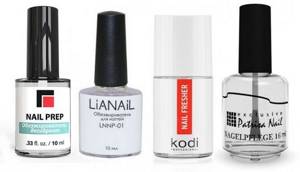
Among dehydrators, the following products deserve attention:
- MILV Nail Prep. This product is applied to the nails after cleansing them and the skin with another degreaser. There is a brush in the bottle that is used for this. The product slightly dries the surface of the nails and has an antibacterial effect. It can be used under gel polish or firming gel.
MILV Nail Prep allows you to wear a manicure for up to 1.5 months. But for problem nails on which the coating does not adhere well, it is not always suitable. The cost of a 16-ml bottle is 170-200 rubles.
- LiaNail. The product handles grease, moisture and dust equally well. You don’t need to use a degreaser before it, just brush your nails with a brush. The product reliably adheres to the coating and dries quickly. Its smell is quite pungent, but fades away easily. The price of the LiaNail dehydrator is 200 rubles. for 10 ml.
- Kodi Professional Nail fresher. The product is highly effective despite its gentle effect on nails. It dehydrates only their top layer. But the coating lasts a long time even with very wet hands. The product from Kodi dries quickly and does not cause allergies. The only drawback is its high cost - 450-500 rubles. for 15 ml. And Kodi is often counterfeited.
- ONIQ. The product instantly dries and cleans the plate without affecting its strength. It has almost no smell, has a comfortable brush and dries quickly. You can use any brand of primer under the dehydrator for the best durability of the coating. It works even for problem nails. The cost of the product is 300 rubles. for 10 ml.
- Patrisa Nail Nail Rev. This product also degreases well and allows you to extend the wearing of the coating. It can be used for any type - gel, gel polish, but after Patrisa Nail Nail Prep you need to apply a primer. The product is gentler than previous products, which does not reduce its effectiveness. It is extremely rare for an allergy to occur. And the dehydrator dries quickly, which means manicures are completed faster. The cost of a 16 ml bottle is 270-330 rubles.
Degreaser

Among traditional degreasers, experts call the following products the best:
- Mozart House. This product can be used to wipe nails and fingertips after a hygienic manicure, as well as remove the sticky layer from the coating. It dries perfectly, eliminating moisture and grease. Therefore, the coating adheres well to very wet hands.
The product is sold in different volumes; a 150 ml bottle costs 200-250 rubles. The disadvantage is that it can only be used for gel polish coating; for extensions, experts say the product is not reliable enough.
- Orly. This product is used to remove nail dust, oil and moisture, but it is also suitable for removing the sticky layer from base or gel polish. It can be used for flower beds and for extensions. The product has a slight odor, has a fairly active effect on the surface of the nails, but does not damage them, and even helps to improve their condition. It has a high cost - 750 rubles. for 118 ml.
- Domix. The product copes with fat, moisture and the dispersion layer of gel polishes and bases. Does not harm nails, does not dry them out, despite the presence of a solvent in the composition. The price is also attractive - 440 rubles. for 1000 ml.
- Irisk. The product is specially designed to remove oil, sweat and dust from natural nails. For greater reliability, a primer is used after it. The product from Irisk not only dries, but also disinfects surfaces, reducing the risk of developing an infection under the coating. You can also remove the sticky layer with a degreaser. The top after it retains its shine and does not become cloudy. The cost of the product is 190 rubles. for 100 ml.
- De Lacroix. The product works as a dehydrator and degreaser, and is used not only for gel polish, but also for extensions and strengthening with gels and acrylics. It should be used when performing a classic manicure, when the cuticle is soaked with water. The product does not lose its advantages even after the hardware procedure. Its cost is 110 rubles. per bottle of 80 ml.
Cleaners
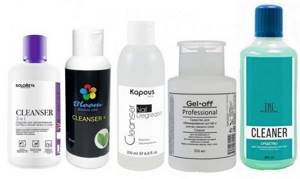
Most good cleansers are 2 in 1 products, that is, they combine liquid for removing dispersed layers and fat from nails and skin:
- Solomeya. The base of the product is isopropyl alcohol, there is also camphor, water and flavoring. It copes equally well with excess moisture, oil on the nails and the sticky layer of the coating. If you remove the dispersion from the finishing product, it will retain its shine. Straw is sold in bottles with a dispenser, which makes use convenient and consumption economical. Price 150 ml – from 350 rub.
- Bloom. The liquid consists of isopropyl alcohol and aloe vera, that is, it not only degreases nails, but also cares for them. It rarely causes intolerance, dries quickly, has almost no odor, because it contains no solvents. Bloom is sold in large and small bottles, the price for 100 ml is 120 rubles.
- Kapous. The product has good drying and disinfecting properties. It is suitable for use with gel strengthening or extensions. A flower garden with a sticky layer does not change shade after wiping with Capus, and the top retains the same shine. The cost of the liquid is 150 rubles. for 200 ml.
- Gel-Off. The product removes fat and moisture, but is also used to remove the sticky layer. It is suitable for natural nails and extensions, as well as tips. Gel-Off dries quite slowly, but has almost no smell. Its cost is 200 rubles. for 250 ml.
- TNLProfessional. This clinser can be used on natural nails under gel polish or for extensions. It degreases and removes moisture well, erases the stickiness from the coating without a trace, without disturbing its gloss or dullness. For the desired effect, a very small amount of product is enough. Another plus is that it has almost no smell. Product price – 400 rub. for 500 ml.
How does an allergy to nail degreasing agent manifest?
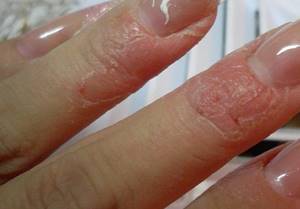
Allergy to nail degreaser is more common than to gel polishes or bases, and manifests itself:
- swelling of the fingertips;
- severe itching of the skin;
- irritation and redness of its surface;
- the appearance first of watery blisters, then of cracks on the pads.
Intolerance can make itself felt only when the manicure is completely completed. After all, the degreaser is not washed off with water, it just needs to dry. In such cases, the covering is removed, ointments are used for the fingers, and antihistamines are taken.
Allergies to Severin degreaser are especially common. It does not contain any unusual components, but many nail technicians complain that their clients are intolerant of the product.
Varnish and base of different brands
Some people believe that it is absolutely forbidden to use products from different brands. But if earlier such an idea was quite common, today most masters claim that this statement is greatly exaggerated.
And yet there is some truth in it. It happens that when using products from different companies, the varnish simply rolls off the base. Before you have time to finish painting your nail, you may notice a bare end or a gap near the cuticle. Let's not argue with the fact that some products are simply categorically incompatible. But in most cases, simply wiping your nails with a clinser is enough.
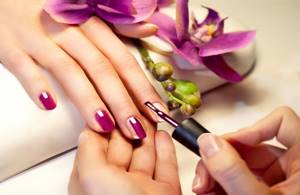
So, an important point that is also worth remembering: after the base, you need to remove the sticky layer if the varnish and base of different brands do not work well together. As a rule, this trick works well. But it also happens that simple wiping is not enough. Then it’s worth going over a well-dried base with a soft buff. There can be no clear recommendations. Experiment to determine which method works best for your materials.
How to use Cleanser plus
- For Cleanser Plus to be effective, you need to know a few simple rules for its use:
- To clean the nails, moisten a lint-free cloth with liquid and carefully wipe the entire surface of the plate, not forgetting to treat the free edge.
- It is recommended to use a degreaser whose brand matches the brand of varnish, top coat, or base. Products from different manufacturers may contain conflicting substances, which leads to darkening and dulling of the coating.
- The effect of the product lasts up to 30 minutes, so the nail plates are treated immediately before applying the coating one by one, and not all at once.
- In the process of creating a gel polish coating, the product consumption is small, so you should not save money or purchase a cheap, low-quality product that can ruin the appearance of the design.

Important! When paired with a cleanser, only lint-free wipes should be used.
Cotton wool and cotton pads are not suitable for treating nail plates, as they leave fine lint on their surface.
How to properly use nail degreaser?
High-quality “dead” adhesion between the nail and the decorative coating is ensured by thorough preparation in several stages. All types of degreasers used must be used correctly, following the following sequence:
- Neil prep (i.e. degreaser) . This is the first step to the perfect manicure. Before use, you need to remove the shine of the nail with a buff. Degrease the surface of the nail with the product. It can be applied directly to the nail and then wiped off with a lint-free cloth. You can soak a napkin with liquid and treat your nails with it.
- Dehydrator . The composition is not always applied. In cases of high sweating on the fingers, you cannot do without it. It is also necessary for the subsequent application of acid-free primer. Acidic does not require treatment of the nail with a dehydrator. The product is applied with a brush, then wiping the nail with a special napkin.
- Primer . Cover the nail with this product very carefully so as not to capture the periungual ridges (regardless of whether it is acidic or not). This should be done with a brush; there is no need to wipe it off.
Next they cover it with bonder (drying it in a lamp), gel polish, gel, etc. Sticky layers are removed with a cleaner.
What not to do
The main thing to avoid is experimenting on your own hands. If you want to see how materials from different brands will work, practice on tips. Be sure to make a mark on the tip if you think it’s better to remove the stickiness from the base!
Do not use household chemicals or medications to remove stickiness. In general, you should be especially careful with any substitutes for professional products.
Never use cotton pads, sponges, napkins, paper or regular cotton balls to remove stickiness. Any material that leaves lint is detrimental to manicure. In extreme cases, lint-free napkins can be replaced with paper tissues. But working with them is much more difficult.
So, we have found answers to the question of whether it is necessary to remove the sticky layer from the base, when it is worth doing this and when not, and also considered what materials should be used for this.
Why do you need a sticky layer on base and gel polish?
Both base and gel polish almost always come with a sticky layer (with the exception of 3-in-1 or single-phase gel polishes). If they don't have tack, or if you take it off, there's a good chance the color will chip off quickly, leaving your nails with just one base. But variations are possible with the top.
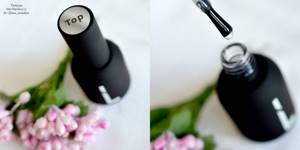
What is Cleanser plus for nails
Cleanser is a degreaser that is necessary at the stage of preparing nails for applying gel polish and removing the sticky layer after the final polymerization of nails in a lamp. It is a liquid, the main component of which is an aqueous-alcohol solution. It also contains a small amount of fragrances and special oils.
In addition to degreasing, cleaning the nails before applying the base coat and adding a glossy shine at the final stage of the manicure, the clinser has several additional functions that not all home manicure lovers know about. The liquid can be used:
- as an antiseptic for treating hands before starting work;
- for disinfection of manicure instruments;
- for washing brushes;
- in some cases - for processing the lamp (not all clinsers have this function).
Without a clinser it is impossible to create a long-lasting manicure; its application promotes good adhesion of the gel polish coating to the surface of the nail.


